

Digital Technologies: An Introduction. The Australian Curriculum v6.0 Digital Technologies Foundation to Year 10 Curriculum by rows. Learning in Digital Technologies focuses on further developing understanding and skills in computational thinking such as decomposing problems and prototyping; and engaging students with a wider range of information systems as they broaden their experiences and involvement in national, regional and global activities.
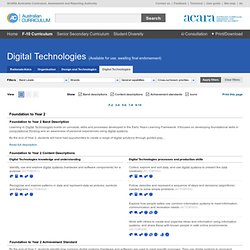
By the end of Year 8, students will have had opportunities to... Read full description By the end of Year 8, students will have had opportunities to create a range of digital solutions, such as interactive web applications or programmable multimedia assets or simulations of relationships between objects in the real world. In Year 7 and 8, students analyse the properties of networked systems and their suitability and use for the transmission of data types. They acquire, analyse, validate and evaluate various types of data, and appreciate the complexities of storing and transmitting that data in digital systems.
Hide full description. Five-Minute Film Festival: Teaching Kids to Code. Whether you're a technophobe or a geeked-out early adopter, there's no denying that the world is run on computers, and the language of computers is code.

It seems only natural that there's a wave of interest in the idea of teaching kids to code -- some say it should be a requirement in every school. I think no one would argue that every kid is cut out to be a programmer, but a basic understanding of code couldn't hurt. In fact, this knowledge could give a leg up in an increasingly technology-centric society. Hopefully this playlist of videos will help you learn more about some of the people and organizations who are working to change the opportunities available for kids to learn code. Video Playlist: Teaching Kids to Code Watch the player below to see the whole playlist, or view it on YouTube.
What Most Schools Don't Teach (05:44) This video by Code.org went viral a year ago. More Resources on Teaching Coding. What is a "computer algorithm" To make a computer do anything, you have to write a computer program.
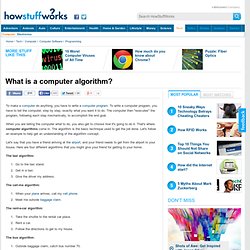
To write a computer program, you have to tell the computer, step by step, exactly what you want it to do. The computer then "executes" the program, following each step mechanically, to accomplish the end goal. What's an algorithm? - David J. Malan. Programming - Branching. Algorithms in Computer Programs are a lot like recipes, but most recipes don't allow the cook to make choices.
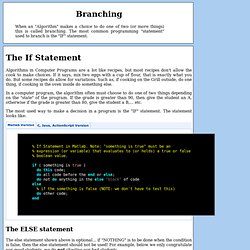
If it says, mix two eggs with a cup of flour, that is exactly what you do. But some recipes do allow for variations. Such as, if cooking on the Grill outside, do one thing, if cooking in the oven inside do something else. In a computer program, the algorithm often must choose to do one of two things depending on the "state" of the program. If the grade is greater than 90, then give the student an A, otherwise if the grade is greater than 80, give the student a B,... etc. The most used way to make a decision in a program is the "IF" statement. . % If Statement in Matlab. The ELSE statement The else statement shown above is optional... if "NOTHING" is to be done when the condition is false, then the else statement should not be used! Grade = % some_number; if ( grade > 75 ) fprintf('congrats, your grade %d is passing\n', grade); end. What is Iteration. User Interface Definition. Why Computers Use Binary.
Binary numbers – seen as strings of 0's and 1's – are often associated with computers.

But why is this? Why every child should learn to code. Next week my daughters turn five.
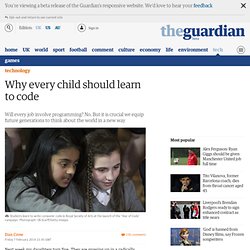
They are growing up in a radically different world to the one I knew when I was a kid. I was one of the generation inspired by the first wave of home computers: I taught myself to program on a ZX81, then a BBC Micro. Those early computers were glacially slow, had almost no storage and you had to write code to get them to do even the simplest task.
Today, I have a computer in my pocket that is more than 100,000 times faster and has 10,000,000 times more memory than a ZX81. It is connected to every other computer on the planet and can access virtually every piece of human knowledge ever created, nearly instantaneously. 3 Ways Coding and Gaming Can Enhance Learning. Coding isn't just for computer science any more.

Educators are finding that teaching students to write code and design games enhances learning and creates engagement. These examples illustrate how coding and games are being used across the curriculum and at all levels, as well as why great teaching is at the very heart of this innovation. Connecting With Each Learner: Inform7 (Interactive Fiction for High School) Imagine a weather-beaten oak door. It has a heavy brass knocker and a tarnished handle that doesn't look like it has been used in some time. Now go to Google Images and try to find a picture of the exact door that you have seen in your head. Now imagine that as you approach the door, you notice deep scratches along the doorframe, as if something has been trying to get in . . . or trying to hold the door closed. Yet through the power of narrative description, we are all probably picturing the same door in our heads.
Great Teachers. Computational Thinking. Sign in / Register Cart Live Chat Translate ▼ Search Learn Computational thinking for all.
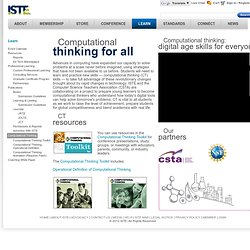
CompThinkingFlyer.